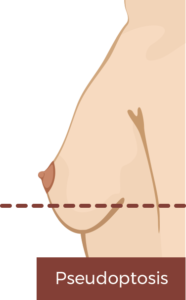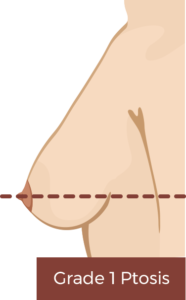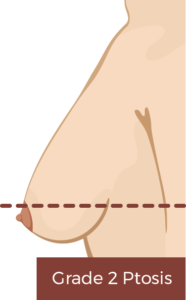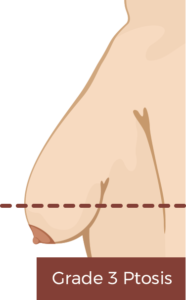Breast lift surgery can reduce signs of sagging skin and give the breasts a more youthful, “perky” appearance. It is very common for breasts to sag and droop over time – the condition is medically referred to as breast “ptosis.” This can be due to a variety of factors, including pregnancy, weight loss, enlarged breasts, or simply the effects of gravity and aging. Regardless of the cause, millions of women are affected by breast ptosis. Dr. Eric Okamoto, our board-certified plastic surgeon, offers advanced breast lift techniques that can help you meet your needs with beautiful, natural-looking results. This procedure has helped many women achieve their goals and feel more confident in their appearance.
The approach taken to address each patient’s concerns is dependent upon many factors, but the most essential question that must be resolved first is whether the patient believes her breasts are appropriately sized, too small or too large. The answer to this question constructs a pathway leading to the most appropriate solution.
If the prospective patient likes her current breast size, then it is a matter of lifting what already exists. She is essentially saying that her breast volume is sufficient but her nipples need to be raised and the skin made tighter with uplifted breasts. In medical terminology, this operation is called a “mastopexy.” This is a condition where too much overstretched skin covers the breast tissue. Correction requires three basic maneuvers: a) raising the nipple-areolar complexes; b) reshaping the underlying breast tissue; c) excising excessive skin.
In cases where the breasts are larger than desired, a partial breast reduction becomes part of the mastopexy. Most of the time this dual operation can be accommodated with the same incisions so as not to create additional scars, but, infrequently, a portion of the scar must run underneath the breast.
When someone with breast ptosis wants larger breasts, typically the best option available is to commit to a combination breast lift with implants (augmentation-mastopexy). Again, this is a dual operation going in the opposite direction of a reduction-breast lift, but where two goals are accomplished together.
When you come in for your breast lift consultation with Dr. Okamoto, he will describe all aspects of the procedure and address any concerns you may have. Once the best treatment options have been determined, he will create a customized treatment plan designed to meet your goals with beautiful, natural-looking results.
Good candidates for breast lift surgery are typically those who would like to:
In addition, ideal candidates for breast lift surgery are individuals who are in reasonably good overall health. During the consultation, Dr. Okamoto will talk with you about your needs and goals and conduct an examination to determine whether breast lift surgery is the best option. The degree of breast ptosis (sagginess) is generally classified in the following way:
 Sometimes referred to as “glandular ptosis,” pseudoptosis has occurred when the breasts droop beneath the inframammary fold (the crease where the breasts and chest come together), but the nipples and areolas remain above the fold.
Sometimes referred to as “glandular ptosis,” pseudoptosis has occurred when the breasts droop beneath the inframammary fold (the crease where the breasts and chest come together), but the nipples and areolas remain above the fold.
 This level of ptosis is characterized by breasts that sag below the fold where the breasts meet the chest, with the nipples meeting the location of the fold.
This level of ptosis is characterized by breasts that sag below the fold where the breasts meet the chest, with the nipples meeting the location of the fold.
 Grade 2 ptosis has occurred when the breasts droop below the inframammary fold and the nipples appear just beneath the fold, as well.
Grade 2 ptosis has occurred when the breasts droop below the inframammary fold and the nipples appear just beneath the fold, as well.
 This is the most severe degree of ptosis, and is characterized by breasts that sag well below the inframammary fold, along with nipples that are below the fold and pointing downward.
This is the most severe degree of ptosis, and is characterized by breasts that sag well below the inframammary fold, along with nipples that are below the fold and pointing downward.
Dr. Okamoto will excise the excess skin, sculpture the underlying breast tissue, and redrape the skin over the reshaped breast. These maneuvers result in firmer, raised breasts with higher nipples, all of which render more youthful-appearing breasts. The most common method of breast lift performed by Dr. Okamoto is the so-called “vertical lift,” which has multiple advantages over other methods used in the past, such as more projection of the breast mound and a significantly shorter scar (see scar section below).
Breast lift surgery is typically performed as an outpatient procedure and generally takes about two hours to complete, depending on your unique needs.
Patients can expect some level of swelling and bruising in the breasts following breast lift surgery. Medication can help control post-surgical pain and discomfort. The recovery periods vary according to how much surgery is required – in general, a two-to-three week convalescence is expected, but full recovery can run much longer. Strenuous activities should be avoided for several weeks. Dr. Okamoto will be able to provide you with a better idea of what to expect regarding the recovery process once he has evaluated your individual needs.
The removal of excess skin is not unlike how a tailor will alter an article of clothing too large for an individual. Just like the tailor leaves seams where extra material has been removed, a plastic surgeon leaves scars where excessive skin has been deleted. As stated above, Dr. Okamoto commonly uses the vertical breast lift method, which creates a round scar encircling the areola and a vertical limb extending from the center of the lower areola down towards the lower part of the breast, the so-called “popsicle scar.” It replaces the more traditional “anchor scar,” which applies a different method of breast lifting.
While many women experience the positive results of breast lift surgery for many years, the natural aging process and other factors will still have an effect on the breasts over time. Sagging of the breasts cannot be completely prevented; however, there are ways that the process can be slowed. Wearing a supportive bra, reducing weight fluctuations, maintaining a healthy diet, staying away from tanning booths, and wearing strong protection when out in the sun can be very helpful. Also, keep in mind that larger breasts will have a greater effect on potential sagging than smaller ones.
While it still may be possible for some women to breastfeed after having a breast lift, there are a number of factors to consider. First, the techniques and incision locations utilized during the procedure will need to be customized with the goal of preserving the function of the milk ducts as much as possible. Even then, it is no guarantee. Keep in mind, a large percentage of women do not have the ability to breastfeed at all. If you are considering breastfeeding in the future, Dr. Okamoto will create a treatment plan based on those goals; however, it is often Dr. Okamoto’s recommendation that women wait to have breast lift surgery until after they have completed their families. This is not only because there is a chance that breastfeeding could be compromised, but also because a future pregnancy and breastfeeding can significantly diminish the results of breast lift surgery.
There are a lot of articles and opinions about exercises that women can do to give their breasts a “natural lift.” The truth is, surgery is really the only way to achieve the best, most significant results. Exercises alone cannot reverse breast sagginess and “drooping,” and they cannot change the shape or position of the breasts. While good posture and certain types of bras may be helpful to keep the breasts looking “perky” to some degree, breast lift surgery is the only viable way to eliminate loose, excess skin and lift the breasts to a more youthful position, giving them a smoother and firmer appearance.
Breast lift surgery can beautifully renew the appearance of the breasts and give them a firmer, more youthful look; however, this procedure is not designed to enhance breast volume to any significant degree. If you are looking to add volume and size to your breasts in addition to addressing sagginess and a “drooping” appearance, breast implants can be combined with a breast lift procedure (which is called a breast augmentation-mastopexy) to help you achieve your goals. Dr. Okamoto will talk with you about your options during the initial consultation and help you determine the best procedure for your needs.
Learn more about breast lift with augmentation.
Breast lift surgery is typically considered an elective cosmetic procedure; therefore, it is generally not covered under medical insurance plans. With this in mind, our practice accepts a comprehensive range of payment methods to make the cost of breast lift surgery as convenient as possible. In addition, we work with CareCredit®, a reputable lending agency which offers an array of budget-friendly plastic surgery financing plans for applicants who qualify.
The most common sensations of discomfort after a breast lift are typically described as soreness, tenderness, swelling, and even some degree of numbness in the breast areas and around the incision locations. These effects should dissipate over the course of the recovery process, and can be controlled with oral pain medicine.
It is perfectly normal to experience swelling in the breasts after breast lift surgery. This side effect can be reduced by wearing the prescribed garments/surgical bras, which will work to keep the blood flowing and protect the incisions. Minimizing intake of alcohol and salt during recovery can also be helpful to control swelling. Eating plenty of foods like citrus fruits and leafy greens, which are high in anti-inflammatory ingredients, in addition to lots of rest and the occasional light walk can aid the recovery process, as well.
In most cases, a sports bra with wide straps and a closed front is often the more ideal type of bra to wear for several weeks following breast lift surgery. We typically advise patients to avoid wearing any kind of bra that is fitted with an underwire for a minimum of eight weeks after a breast lift.
If you have questions about breast lift surgery, or if you would like to schedule a consultation, please contact Dr. Okamoto today.
*Individual results may vary
